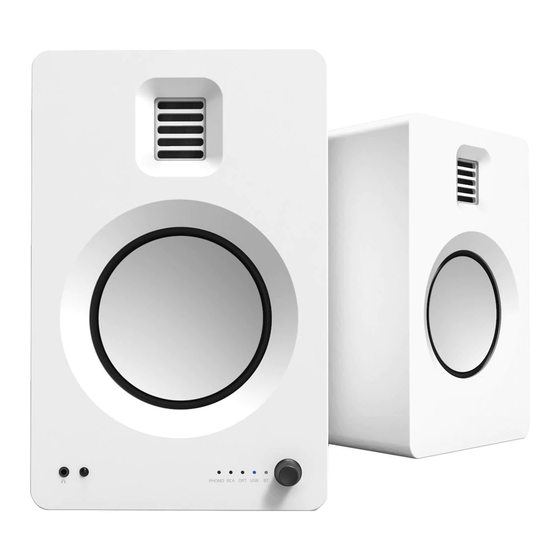
Table of Contents
Advertisement
Advertisement
Table of Contents

Summary of Contents for Kanto Tuk
- Page 1 English User Manual TUK Powered Speakers Supporting your digital lifestyle ™...
-
Page 3: Table Of Contents
Important Safety Precautions . Introduction What’s in the Box? Front & Rear Panels . Remote Control . Setting up TUK Connecting Audio Sources Connecting to a Turntable Connecting to a Smart Home Device Connecting to a Computer Connecting to a TV or Home Theater System Connecting Bluetooth Connecting a Subwoofer . -
Page 4: Introduction
Its wide range of connectivity makes it perfectly suited as both a near field and home audio solution. We recommend you read all instructions carefully before using TUK and keep them for future reference. Kanto cannot be liable for damage or injury caused by incorrect setup or use of this product. -
Page 5: Front & Rear Panels
Volume Adjust / Input Select / Standby Input LED Display 3.5 mm Headphone Output Remote IR Receiver TUK’s volume knob functions as an input select knob as well. Push the knob to select an input source - it cycles through the following inputs depending on what input source was last used. -
Page 6: Remote Control
Remote Control Install two supplied AAA batteries in the back of your TUK remote. Remote Control functions are listed below. Standby On / Off Input Select Volume Adjust INPUT Mute Treble Adjust Sub Mute Bass Adjust LED Brightness Adjust Bass Reset... -
Page 7: Setting Up Tuk
Switch to ON once all the inputs have been plugged in. TUK is designed to perform optimally when positioned at least 8” from the rear wall in an average listening room. However, it may not be possible to install the speaker in this position and since rooms vary in shape, size, and furnishing, a certain amount of experimentation is necessary to determine the most suitable position. - Page 8 Setting up TUK Start-up / Shut-down time TUK can take up to 6 seconds to boot up and shut down. During this time the speaker will not respond to remote commands or adjustments to the Volume / Input knob. Do not attempt to adjust any settings while TUK is starting up as it may cause a jarring change when audio starts playing.
-
Page 9: Connecting Audio Sources
USB A / B cable (commonly referred to as a "printer cable", included) • TUK features a built in Phono Pre-Amp that allows you to connect directly to a turntable. Please see Pg. 10 for more information about connecting turntables •... -
Page 10: Connecting To A Turntable
TUK features a phono input for use with turntables that do not contain built-in pre-amps. 1. While the speakers are in standby or OFF, plug your turntable’s audio cables into the right and left PHONO input of TUK. If your turntable has a ground wire, connect it to the GND post of TUK. -
Page 11: Connecting To A Computer
2. While the speakers are in standby or OFF, plug one end of the optical cable into the TV and the other into the OPT input of TUK. Take note of the shape of the cable and port as you can only insert the cable in one orientation. -
Page 12: Connecting Bluetooth
Pairing is easy. 1. Press the Input button on TUK’s remote to select BT as the input source. You can also cycle through inputs by pressing the knob on the front of TUK. The BT Input LED will blink slowly for 8 seconds while it attempts to pair with the last known device. -
Page 13: Connecting A Subwoofer
The sub output will be reactivated upon waking up from standby. Active Crossover TUK is equipped with an active crossover filter at 80 HZ to allow for advanced setup with subwoofers. Activating the crossover will reduce the bass extension of the main speakers, allowing them to focus on the mid and high frequencies, while reducing the high frequency output of the SUB OUT port. -
Page 14: Special Functions
Automatic Power Up (APU) / Automatic Power Down (APD) TUK is designed to save power when not in use. When no audio signal has been detected for 15 minutes, TUK will put itself into standby mode (APD). If the audio signal returns via the same input that TUK was playing when it entered standby, TUK will wake up and resume playing (APU). -
Page 15: Audio Troubleshooting Guide
Bluetooth SIG, Inc. and any ® use of such marks by Kanto Distribution Inc. is under license. NOTICE: Qualcomm is a trademark of Qualcomm Incorporated, registered in the United States and other countries. -
Page 16: Limited Warranty To Original Purchaser
2 years. If equipment fails because of such defects and Kanto is notified within 2 years from the date of shipment with proof of original invoice from an authorized reseller, Kanto will, at its option, provide replacement parts or replace the equipment, provided that the equipment has not been subjected to mechanical, electrical, or other abuse or modifications.















Need help?
Do you have a question about the Tuk and is the answer not in the manual?
Questions and answers